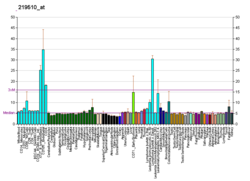DNA polymerase theta is an enzyme that in humans is encoded by the POLQ gene. [5] [6] This polymerase plays a key role in one of the three major double strand break repair pathways: theta-mediated end joining (TMEJ). [7] [8] [9] [10] Most double-strand breaks are repaired by non-homologous end joining (NHEJ) or homology directed repair (HDR). However, in some contexts, NHEJ and HR are insufficient and TMEJ is the only solution to repair the break. [11]
Contents
TMEJ is often described as alternative NHEJ, but differs in that it lacks a requirement for the Ku heterodimer, and it can only act on resected DNA ends. [12] Following annealing of short (i.e., a few nucleotides) regions on the DNA overhangs, DNA polymerase theta catalyzes template-dependent DNA synthesis across the broken ends, stabilizing the paired structure. [13] [14]




